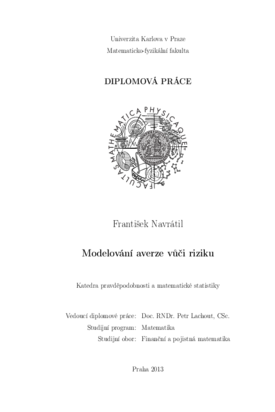Modelování averze vůči riziku
Modeling of risk aversion
diplomová práce (OBHÁJENO)

Zobrazit/
Trvalý odkaz
http://hdl.handle.net/20.500.11956/59016Identifikátory
SIS: 117020
Kolekce
- Kvalifikační práce [10690]
Autor
Vedoucí práce
Oponent práce
Kopa, Miloš
Fakulta / součást
Matematicko-fyzikální fakulta
Obor
Finanční a pojistná matematika
Katedra / ústav / klinika
Katedra pravděpodobnosti a matematické statistiky
Datum obhajoby
18. 9. 2013
Nakladatel
Univerzita Karlova, Matematicko-fyzikální fakultaJazyk
Čeština
Známka
Výborně
Klíčová slova (česky)
Averze vůči riziku, užitková funkce, pravděpodobnostní omezeníKlíčová slova (anglicky)
Risk aversion, utility function, probability constraintdiplomové práce Název práce: Modelování averze vůči riziku Autor: František Navrátil Katedra: Katedra pravděpodobnosti a matematické statistiky Vedoucí diplomové práce: Doc. RNDr. Petr Lachout, CSc. Abstrakt: Práce se zabývá modelováním subjektivního vztahu investora k riziku. Cílem práce je přehledně shrnout několik možných přístupů k této problematice a následně je aplikovat v reálné situaci. Jednou z možností, jak modelovat tuto rizikovou averzi, je využít teorii očekávaného užitku a specifický tvar užitkové funkce. Dále lze uvažovat vhodnou rizikovou míru. Speciálně třída spektrálních rizikových měr umožňuje investorovi vybrat jemu vyhovující funkci rizikového spektra. Práci doplňuje část o stochastickém programování - teorii, jež je nutná pro řešení souvisejících optimalizačních úloh. Klíčová slova: Averze vůči riziku, užitková funkce, pravděpodobnostní omezení.
of the master thesis Title: Modeling of risk aversion Author: František Navrátil Department: Department of Probability and Mathematical Statistics Supervisor: Doc. RNDr. Petr Lachout, CSc. Abstract: The thesis discusses various theories that are able to model investor's subjective attitude to risk. The goal of the thesis is to clearly recapitulate possible mathematical approaches and to apply them in a real situation. One of the ways to tackle the problem is to use expected utility theory and a specific shape of a utility function. Another way is to choose a suitable risk measure. Especially useful for the modelling of risk aversion is the class of spectral risk measures that enables investor to choose a risk spectrum that meets his perception of risk. The thesis contains basic definitions concerning stochastic programming - a theory essential to solve the related optimization problems. Keywords: Risk aversion, utility function, probability constraint.
